On a breezy afternoon last week, a rainbow appeared overhead when 89-year-old Chinese Nationalist Party (KMT) veteran Chen Pang-hsin (陳邦信) met Kent Mathieu, a 71-year-old American veteran who left his Texas home to serve “in a place called Formosa” in 1965 when he was 23 years old.
Reminiscing through a translator, the two men exchanged old photographs and compared memories. Their conversation revolved around life at the Taipei Air Station, an American base operating in the area surrounding Toad Mountain (蟾蜍山) between the 1950s and 1970s as part of the Military Assistance Advisory Group’s effort to facilitate military aid to Taiwan.
“Only military men were allowed to work there … We were ordered not to reveal anything [inside the base] to people outside,” Chen recalls.
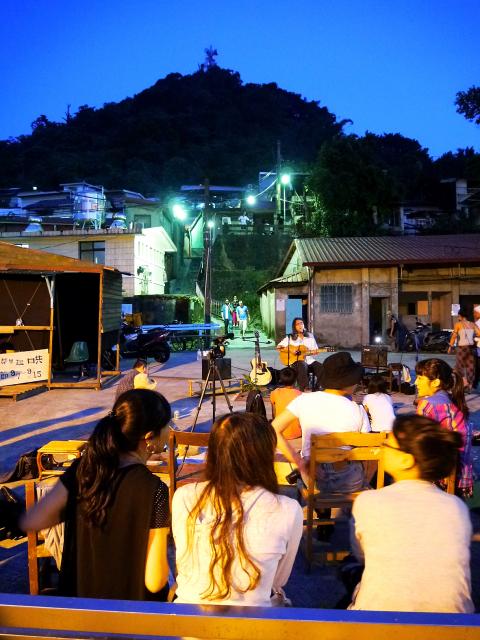
Photo courtesy of Good Toad Club
Chen is one of the few surviving KMT veterans who worked at the American base during their residence in the military settlement built along the lush Toad Mountain, which today is also home to 200 residents, half of whom are other remaining veterans and their offspring.
Demolishing a community
Like the ramshackle quarters of Huaguang (華光) and Shaoxing (紹興), the Toad Mountain neighborhood — known as Huanmin Village (煥民新村) — will probably be demolished to make way for new development.
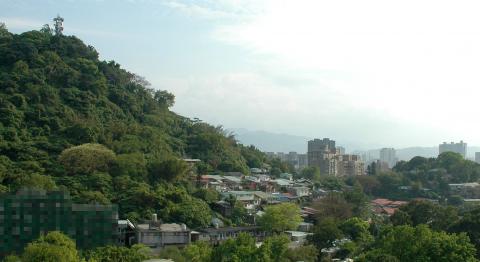
Photo courtesy of Good Toad Club
In 2000, the Taipei City Government allotted parts of the area to the National Taiwan University of Science and Technology (NTUST).
This year, NTUST sued two households for illegal occupation of the land, even though the urban renewal plan stipulates that all residents in the community must be properly relocated before any development plan is carried out. But there is currently no government budget for this relocation.
Meanwhile, the university asked the Ministry of Defense (MND) to bulldoze the 39 dormitories left vacant by villagers relocated in 2011. If the MND complies, the dorms will be gone within two months.
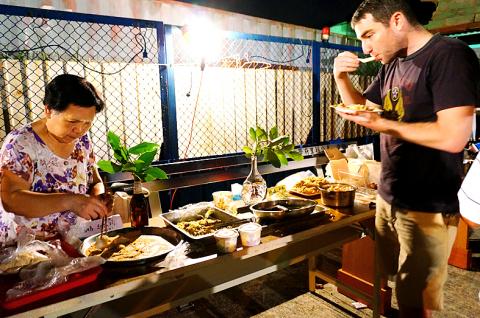
Photo courtesy of Good Toad Club
Preserving a plot of history
In response to the planned demolition, a group of residents, artists, university students and professors have come together in a bid to preserve the area’s unique history.
“This is a place where we can see the changes of Taipei over the period of more than 200 years,” says Lin Ting-chieh (林鼎傑), a documentary filmmaker who has lived in the settlement for five years.
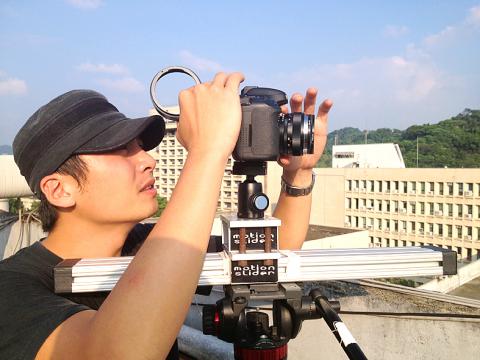
Photo courtesy of Good Toad Club
Adjacent to the perpetually jammed intersection of Roosevelt Road (羅斯福路) and Keelung Road (基隆路), the solitary settlement feels like a world apart.
Huts and houses abut narrow, winding paths. Some are remnants from the Japanese colonial era. A few were built with bricks and other material that came from the American base, which has disappeared. An ancient trail that’s almost 300 years old is covered by a layer of asphalt — a sign of the times.
The settlement dates to the Qing Dynasty, when the Han Chinese drove away the Aboriginal inhabitants. Then came the Japanese, followed by the Americans and Chiang Kai-shek’s (蔣介石) troops as they retreated to Taiwan in the late 1940s.
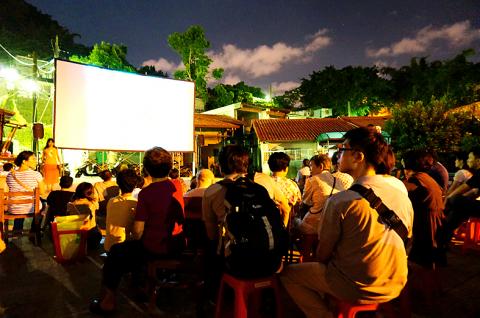
Photo courtesy of Good Toad Club
Dormitories were subsequently set up for KMT Air Force officers, while soldiers and other low-ranking military personnel were allowed to build houses. Over the next few decades, old tenants moved out or passed away. Others remained, living next to newcomers looking for work in the capital.
For residents like Chang Pei-mei (張貝梅), although the neighborhood may look shabby, it’s a good place to live and raise a family.
“Back in the old days, this was all farmland. After school, kids would play in the fields. It’s relatively isolated and cars are very rare. Even the air is much fresher,” says 72-year-old Chang, who has lived here for half a century, having raised three sons with her husband.
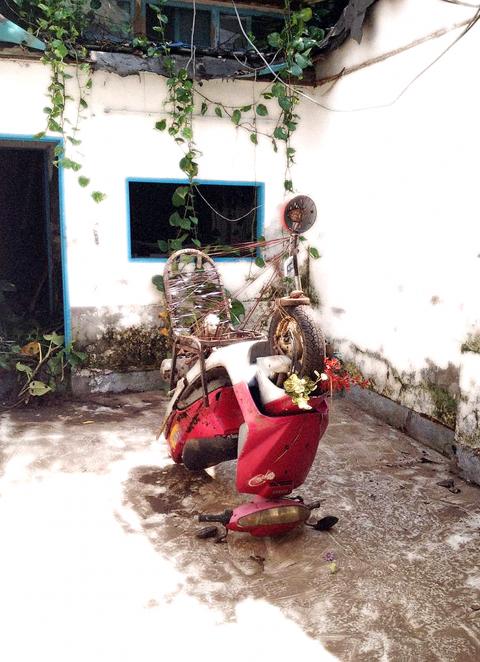
Photo courtesy of Good Toad Club
Long before the existence of today’s Roosevelt Road, Han-Chinese settlers laid a trail through Toad Mountain to connect Jingmei (景美) and Sindian (新店) with the Taipei Basin in the early 1700s. The trail still exists today.
In 1736, the Qing imperial government set up Gongguan (公館), a government post for the purpose of taxation and fortification, as the area grew to become a bustling trading hub.
By the mid-18th century, a Chinese landlord named Kuo Hsi-liu (郭錫?) completed the Liugong Canal (?公圳), an ambitious irrigation system that drew water from the Sindian River (新店溪) to irrigate large parts of Taipei Basin. The canal split into three watercourses at the foot of Toad Mountain, and one main course flowed through the settlement.

Photo courtesy of Good Toad Club
To Chang, who moved here in 1963 when she and her husband bought a hut from a KMT veteran for NT$20,000, the bygone life around the canal is still vivid in her mind.
“My husband used to take a bath in the river after getting off work at the bus station in the evening… Women went down to wash clothes by the river; kids went swimming and frolicked in it,” Chang recalls.
The canal was covered up in the late 1970s, and the site of the old watercourse is part of today’s Lane 119, Roosevelt Road, Section 4 (羅斯福路四段119巷). However, the “river” has not disappeared.
“One or two years ago, the street was dug up and I saw a torrential river underneath the road,” Lin says. “Since there is little traffic here, I think the area is one of the few places in Taipei where the historical canal can be restored.”
Taiwan-US relations
Kang Min-jay (康旻杰), an associate professor at National Taiwan University’s Graduate Institute of Building and Planning, says one of the most fascinating aspects of the settlement is its little-known connection to the Taipei Air Station.
“Though more research is needed, it is reasonable to assume that this military settlement provided the labor force for the Americans. People worked as drivers, cleaners and other menial jobs to keep the base running. There was an interesting coexistence between the two,” Kang points out.
For example, Chen, who has lived in the settlement since 1954, had worked at the base as a chauffeur for many high-ranking officers including Benjamin Oliver Davis Jr, Vice Commander of the Thirteenth Air Force, who lived at the Taipei Air Station.
“I drove general Davis to dine with [Chiang Kai-shek] and his wife at their presidential home every night,” the old soldier says.
Mathieu says he worked at the base between 1965 and 1968. He didn’t know any Taiwanese inside the base, but remembers that local military men worked as drivers or mechanics.
“If there was a US vehicle of some sort, they always had a Chinese driver driving it,” he recalls.
Mathieu notes that US military advisers worked closely with the KMT’s air force, training them “in fighting techniques, forming tactics and new ways of doing things.”
Toad Mountain was hollowed out to house the Joint Air Operations Center, which is still in operation.
While the American advisers officially left Taiwan on April 30, 1979, Mathieu says that by the late 1960s, the number of US personnel had dwindled, as “pretty much all the training that was necessary had been done, and new equipment had come in.”
Around the same time, the American base was torn down to make way for the overhead expressway on Keelung Road.
In 2005, Mathieu set up a blog (taipeiairstation.blogspot.tw) dedicated to the history of Taipei Air Station. Former servicemen have contributed to its online archive of documents and records.
“The blog is to preserve the history and keep it open. People put in files, available for years, hopefully forever … People see this stuff, use it and pass it onto their blogs and Web pages,” Mathieu says. “Many young people don’t know [Americans] were here. But it is interesting history.”
Uncertain future
In another bid to preserve that history, documentary filmmaker Lin Ting-chieh launched the Good Toad Club (好蟾蜍俱樂部) in April.
The club has invited artists and members of the public to clean up the vacant homes and to explore creative ways to use the community. They have held a series of music performances, guided tours, exhibitions and a screening of Hou Hsiao-hsien’s (侯孝賢) Daughter of the Nile (尼羅河女兒), which was shot near Toad Mountain in 1987.
This month, Hou will lead other filmmakers to shoot movies in the area as part of the upcoming Golden Horse Festival. Meanwhile, organizers of the Bi-City Biennale of Urbanism/Architecture in Hong Kong and Shenzhen plan to incorporate Toad Mountain as one of its exhibition and event venues, though NTUST has yet to agree.
Lin says that as the government lacks funding for resettlement, the new development NTUST hopes for is unlikely to happen soon.
“So it does nobody good by tearing down the vacant air-force dormitories. Our appeal is that when you can’t build new buildings, why not let something good happen here … It’s more practical to preserve the place and revive it in creative ways,” Lin says.
For Kang, Toad Mountain is a priceless living artifact.
“Like Treasure Hill, Toad Mountain has rich historical layers. You can’t pinpoint it on a specific point in history. Its value lies exactly in the multiple layers of different time periods, offering an interesting profile of Taiwan,” the academic says.
After a series of mediation meetings in September, NTUST and MND agreed to halt the demolition work till the end of this year. But the university rescinded the decision last week and asked the MND to proceed with demolition.
In response, the Good Toad Club has initiated a campaign to have the Taipei City Government designate the 39 dorms as historical architecture.

On April 26, The Lancet published a letter from two doctors at Taichung-based China Medical University Hospital (CMUH) warning that “Taiwan’s Health Care System is on the Brink of Collapse.” The authors said that “Years of policy inaction and mismanagement of resources have led to the National Health Insurance system operating under unsustainable conditions.” The pushback was immediate. Errors in the paper were quickly identified and publicized, to discredit the authors (the hospital apologized). CNA reported that CMUH said the letter described Taiwan in 2021 as having 62 nurses per 10,000 people, when the correct number was 78 nurses per 10,000

As we live longer, our risk of cognitive impairment is increasing. How can we delay the onset of symptoms? Do we have to give up every indulgence or can small changes make a difference? We asked neurologists for tips on how to keep our brains healthy for life. TAKE CARE OF YOUR HEALTH “All of the sensible things that apply to bodily health apply to brain health,” says Suzanne O’Sullivan, a consultant in neurology at the National Hospital for Neurology and Neurosurgery in London, and the author of The Age of Diagnosis. “When you’re 20, you can get away with absolute

May 5 to May 11 What started out as friction between Taiwanese students at Taichung First High School and a Japanese head cook escalated dramatically over the first two weeks of May 1927. It began on April 30 when the cook’s wife knew that lotus starch used in that night’s dinner had rat feces in it, but failed to inform staff until the meal was already prepared. The students believed that her silence was intentional, and filed a complaint. The school’s Japanese administrators sided with the cook’s family, dismissing the students as troublemakers and clamping down on their freedoms — with

As Donald Trump’s executive order in March led to the shuttering of Voice of America (VOA) — the global broadcaster whose roots date back to the fight against Nazi propaganda — he quickly attracted support from figures not used to aligning themselves with any US administration. Trump had ordered the US Agency for Global Media, the federal agency that funds VOA and other groups promoting independent journalism overseas, to be “eliminated to the maximum extent consistent with applicable law.” The decision suddenly halted programming in 49 languages to more than 425 million people. In Moscow, Margarita Simonyan, the hardline editor-in-chief of the